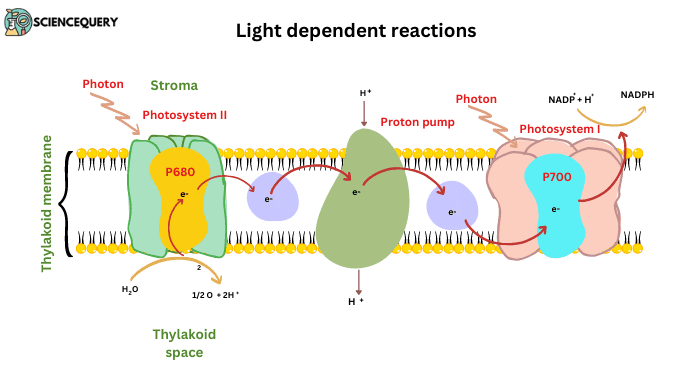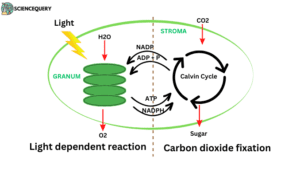
Know in one minute about light-dependent reactions
|
Introduction
Definition
- Light reactions done in the presence of light are hence called Light-dependent reactions. This reaction takes place in the grana of the chloroplast.
- In the presence of light chlorophyll produced ATP, NADPH + H, and oxygen gas as a by-product.
About Light-dependent reaction
- In this reaction, light energy is used as a photon, and NADPH + H+ ATP is produced.
- All photosynthetic animals used NADPH + H+ as a reducing factor.
Components in Light reaction
1. Photosynthetic Pigments
- Photosynthetic pigments are present in the chromatophores.
- These pigments capture light energy and convert light energy to chemical energy.
Pigments that capture the sunlight
I. Chlorophyll has two types
a. Chlorophyll-a
b. Chlorophyll-b
II. Carotenoids have two types
a. Carotenes
b. Xanthophylls
III. Phycobilins have two types
a. Phycoerythrin
b. phycocyanin
2. Photosystem
- Photosynthetic pigments are assigned into groups called photosystems.
- It is initiated when photosynthetic pigments capture light energy.
- Photosystem consists of a reaction center and light-harvesting complex also called an antenna.
Reaction center
- The reaction center consists of a special chlorophyll pair and a primary electron acceptor.
Types of photosystem
There are two types of photosystems according to two photochemical processes
1. Photosystem-I (PS-I)
2. Photosystem-II (PS-II)
1. Photosystem-I (PS-I)
- In this system reaction center is P-700, it absorbs longer wavelengths of light i.e. 700nm
- In their cycling photophosphorylation occurs independently.
- It is present in grana and stroma both.
- Generates strong reductant capable of reducing NADP+
2. Photosystem-II (PS-II)
- PS-II– In this system reaction center is P-680, it absorbs the shorter wavelength of light i.e. 680nm
- There is non-cyclic photophosphorylation present with PS-I
- It is present in grana.
- Generates strong oxidant capable of oxidizing H2O
Facts about Light-dependent reaction
- The light reaction is discovered by Robert Hill in 1937 that’s this reaction is also called the Hill reaction.
- The light reaction is the most important for photosynthesis because photosynthesis demands used energy and the energy source is the sun itself.
- The light reaction is a kind of preparatory phase for photosynthesis to produce sugar.
- In this reaction ATP is formed by ADP hence the reaction is also called photophosphorylation.
- In light reaction the donor of the electron is H2O and the electron acceptor is NADP.
- ATP and NADPH + H worked as a carrier for transporting energy from dark reactions.
- H ion reduced NADP to NADPH + H which formed by hydrolysis of H2O
Steps
The light reaction is completed in 5 steps
1. Absorption of light energy by chlorophyll
- Chlorophyll which is present in leaves is absorbed radiant energy of sunlight and transferred to the reaction center.
2. Transfer of light energy from accessory pigments to chlorophyll-a
- Except chlorophyll-a other, all photosynthetic pigments are called accessory or antenna chlorophyll.
- Absorb light energy by accessory chlorophyll is transferred to the reaction center, P-700, which participates in the primary photochemical reaction.
3. Activation of chlorophyll-a molecules by photons of light
- Chlorophyll molecules absorb sunlight as a photon and go into the ground state to the excited stage for this reason photolysis of water occurs.
4. Photolysis or photochemical oxidation of water and evolution of Oxygen
- Photolysis of water done at the time of PS-II in the presence of Mn++ Cl– ions.
- When chlorophyll reacts chemically with initiated water molecules PS-II is activated, then water molecules dissociate into H and OH ions.
- Electrons are released from OH ions and formed OH radicals and oxygen gas is released.
5. Electron transport and the production of assimilatory power
- Chlorophyll absorbs photons and goes into an excited state, then releases energy and back to the ground state.
- Released energy and electrons enter both photosystems.
- Electrons reduced NADP and produced NADP + H
- Electron-carried energy is used in the electron transport system for producing ATP.
- So in the presence of light chlorophyll produced ATP with the help of ADP and inorganic phosphate.
Light reaction
2NADP + 2H2O + 2ADP + 2Pi → 2NADPH + 2H + 2ATP + O2
Pathway of electron flow
In chloroplast, the energy can be used in 2 ways
1. Cyclic electron flow
It is a pathway in which photoexcited electrons come back to the chlorophyll from which they were lost.
2. Non-cyclic pathway
It is the transport of electrons in which electrons do not move in the cycle and make end product ATP, NADPH, and oxygen.

Significance
The light reaction is most important for photosynthesis. For making food plants need energy that is provided by light reactions.
Dark reactions completely depend on light reactions. For phosphorylation of Phosphoglyceric acid (PGA) and used for reduction of CO2. Light reactions provide NADPH and ATP to dark reactions.
Q&A
Where do light-dependent reactions occur?
Light-dependent reactions happen in the grana of the chloroplast. Their light-harvesting complex is present; they absorb the light and produce energy for making carbohydrates.
Where do light-dependent reactions take place?
The grana of the chloroplast.
What are the products of light-dependent reactions?
The product of the light reaction is 2NADPH, 2H, 2ATP, and oxygen as a by-product.
Which process occurs during the light-dependent reactions in photosynthesis?
The photophosphorylation process occurs during the light-dependent reactions in photosynthesis.
How are the dark reactions that occur in plants dependent on the light reactions?
In the dark reaction, carbohydrates are produced. For producing sugar plants need energy and reducing agents. Dark reaction depends on light reaction for ATP and NADPH+ H

